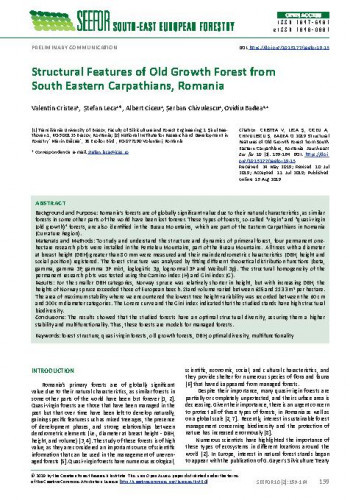Background and Purpose: Romania’s forests are of globally significant value due to their natural characteristics, as similar forests in some other parts of the world have been lost forever. These types of forests, so-called "virgin" and "quasi-virgin (old growth)" forests, are also identified in the Buzau Mountains, which are part of the Eastern Carpathians in Romania (Curvature Region). Materials and Methods: To study and understand the structure and dynamics of primeval forest, four permanent one-hectare research plots were installed in the Penteleu Mountains, part of the Buzau Mountains. All trees with a diameter at breast height (DBH) greater than 80 mm were measured and their main dendrometric characteristics (DBH, height and social position) registered. The forest structure was analysed by fitting different theoretical distribution functions (beta, gamma, gamma 3P, gamma 3P mixt, loglogistic 3p, lognormal 3P and Weibull 3p). The structural homogeneity of the permanent research plots was tested using the Camino index (H) and Gini index (G). Results: For the smaller DBH categories, Norway spruce was relatively shorter in height, but with increasing DBH, the heights of Norway spruce exceeded those of European beech. Stand volume varied between 615 and 1133 m3 per hectare. The area of maximum stability where we encountered the lowest tree height variability was recorded between the 60 cm and 100 cm diameter categories. The Lorenz curve and the Gini index indicated that the studied stands have high structural biodiversity. Conclusions: The results showed that the studied forests have an optimal structural diversity, assuring them a higher stability and multifunctionality. Thus, these forests are models for managed forests.
Sažetak

 South-east European forestry : SEEFOR : international scientific journal in field of forestry : 10,2(2019) / editor-in-chief Dijana Vuletić.
South-east European forestry : SEEFOR : international scientific journal in field of forestry : 10,2(2019) / editor-in-chief Dijana Vuletić.